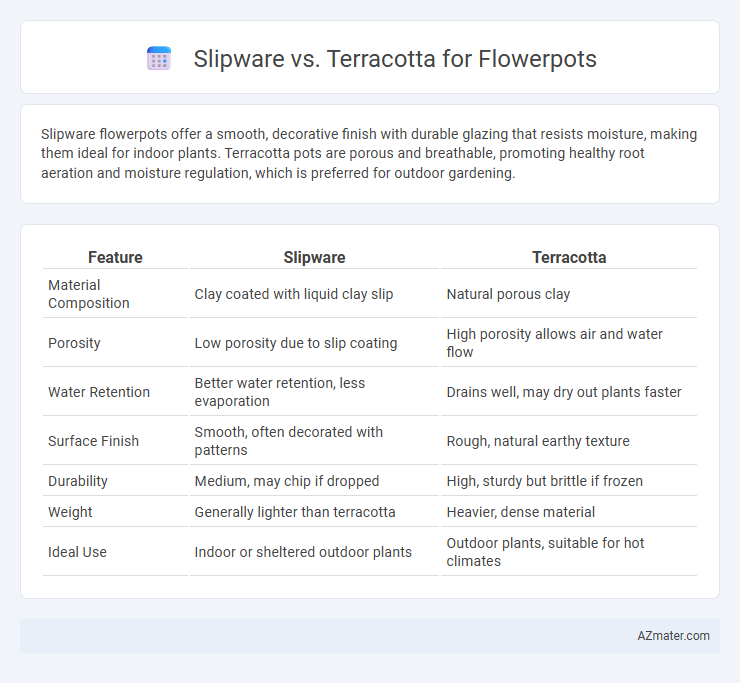Slipware flowerpots offer a smooth, decorative finish with durable glazing that resists moisture, making them ideal for indoor plants. Terracotta pots are porous and breathable, promoting healthy root aeration and moisture regulation, which is preferred for outdoor gardening.
Table of Comparison
| Feature | Slipware | Terracotta |
|---|---|---|
| Material Composition | Clay coated with liquid clay slip | Natural porous clay |
| Porosity | Low porosity due to slip coating | High porosity allows air and water flow |
| Water Retention | Better water retention, less evaporation | Drains well, may dry out plants faster |
| Surface Finish | Smooth, often decorated with patterns | Rough, natural earthy texture |
| Durability | Medium, may chip if dropped | High, sturdy but brittle if frozen |
| Weight | Generally lighter than terracotta | Heavier, dense material |
| Ideal Use | Indoor or sheltered outdoor plants | Outdoor plants, suitable for hot climates |
Introduction to Slipware and Terracotta Flowerpots
Slipware flowerpots are crafted by applying a liquid clay slip over a terracotta base, creating a smooth, decorative surface often glazed for added durability. Terracotta flowerpots are made from natural, porous clay fired at low temperatures, prized for their breathability and rustic, earthy appearance that supports healthy plant roots. Comparing slipware and terracotta flowerpots highlights differences in texture, water retention, and aesthetic appeal, influencing gardeners' choices based on plant needs and design preferences.
Historical Background of Slipware and Terracotta
Slipware, originating from ancient civilizations such as the Romans and later popularized during the medieval period in Europe, involves decorating pottery with liquid clay slips to create intricate patterns and vibrant surfaces. Terracotta, dating back to prehistoric times and widely used in cultures worldwide, is a porous earthenware made from natural clay, known for its reddish-brown color and durability primarily used for practical items including flowerpots. The historical development of slipware emphasizes artistic expression and surface decoration, while terracotta has maintained its reputation for functional, rustic pottery essential in gardening practices.
Material Composition: Slipware vs Terracotta
Slipware flowerpots feature a clay base coated with a liquid clay slip that creates a smooth, often decorative surface, enhancing durability and resistance to water. Terracotta pots are made from natural, porous red or brown clay that allows excellent breathability and moisture regulation for plant roots but can be more fragile and prone to cracking. The key difference in material composition is slipware's protective slip coating versus terracotta's unglazed, porous clay body, affecting water retention and longevity.
Aesthetic Appeal: Color, Texture, and Design
Slipware flowerpots exhibit vibrant, glossy surfaces achieved through the application of liquid clay slips in various colors, offering intricate patterns and smooth textures that enhance visual appeal. Terracotta pots possess a warm, natural reddish-brown hue with a matte, porous texture, giving a rustic, earthy aesthetic that complements outdoor and garden settings. The design versatility of slipware allows for artistic, decorative motifs, while terracotta's simplicity and traditional form emphasize organic beauty and timeless charm.
Durability and Longevity Comparison
Slipware flowerpots, coated with a protective slip glaze, exhibit enhanced durability by resisting water penetration and surface wear more effectively than unglazed terracotta pots. Terracotta flowerpots, made from porous clay, offer natural breathability but are more prone to chipping, cracking, and weather damage over time, reducing their longevity outdoors. Choosing slipware ensures a longer-lasting flowerpot suitable for diverse climates, while terracotta suits moderate environments where natural moisture exchange is prioritized.
Breathability and Drainage for Plant Health
Slipware flowerpots feature a glassy, partially sealed surface from the slip coating that reduces air and water permeability, limiting breathability essential for healthy root oxygenation. Terracotta pots, made from porous clay, allow superior air exchange and moisture evaporation, promoting effective drainage and preventing waterlogged soil conditions. Choosing terracotta over slipware enhances plant health by maintaining balanced soil moisture and oxygen levels critical for root development.
Temperature Regulation Properties
Slipware flowerpots, coated with a smooth slip layer, offer moderate temperature regulation by providing a slight barrier against rapid heat changes, which helps protect plant roots. Terracotta pots, made from porous clay, excel in temperature regulation through natural breathability, allowing air and moisture exchange that cools the soil in hot weather and retains warmth during cooler periods. The enhanced thermal insulation of terracotta supports healthier root environments compared to the less breathable slipware surface.
Maintenance and Cleaning Differences
Slipware flowerpots feature a glazed surface that resists dirt buildup and stains, making them easier to clean with mild soap and water compared to porous terracotta pots. Terracotta pots absorb moisture and soil particles, often requiring more frequent scrubbing and occasional deep cleaning to prevent mold and mineral deposits. Slipware's smooth finish reduces maintenance time, while terracotta demands careful handling to avoid chipping during cleaning.
Cost and Accessibility
Slipware flowerpots generally have a higher cost due to the labor-intensive process of applying slip decoration, making them less accessible for budget-conscious buyers. Terracotta pots, crafted from natural clay and fired at lower temperatures, offer a more affordable and widely available option for gardeners. Their porous nature also makes terracotta pots a popular, cost-effective choice for plants requiring good drainage.
Choosing the Right Pot: Slipware or Terracotta?
Slipware flowerpots offer a decorative, glazed surface that enhances moisture retention and visual appeal, making them ideal for indoor plants or ornamental use. Terracotta pots provide superior breathability with their porous nature, promoting healthy root aeration and soil drying, suitable for outdoor gardening and drought-tolerant plants. When choosing between slipware and terracotta, consider the plant's water needs, environment, and aesthetic preference to ensure optimal growth and pot longevity.

Infographic: Slipware vs Terracotta for Flowerpot
 azmater.com
azmater.com